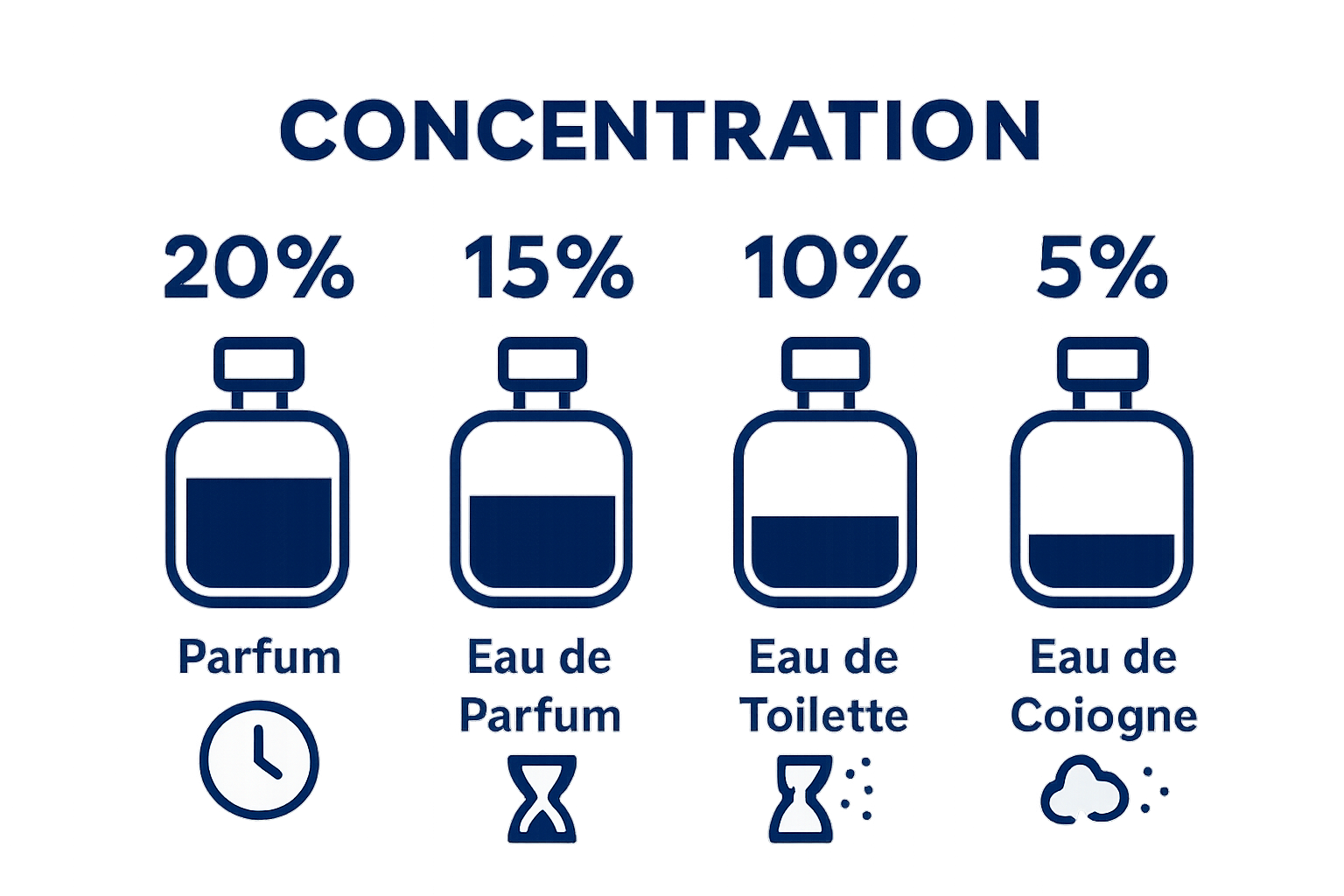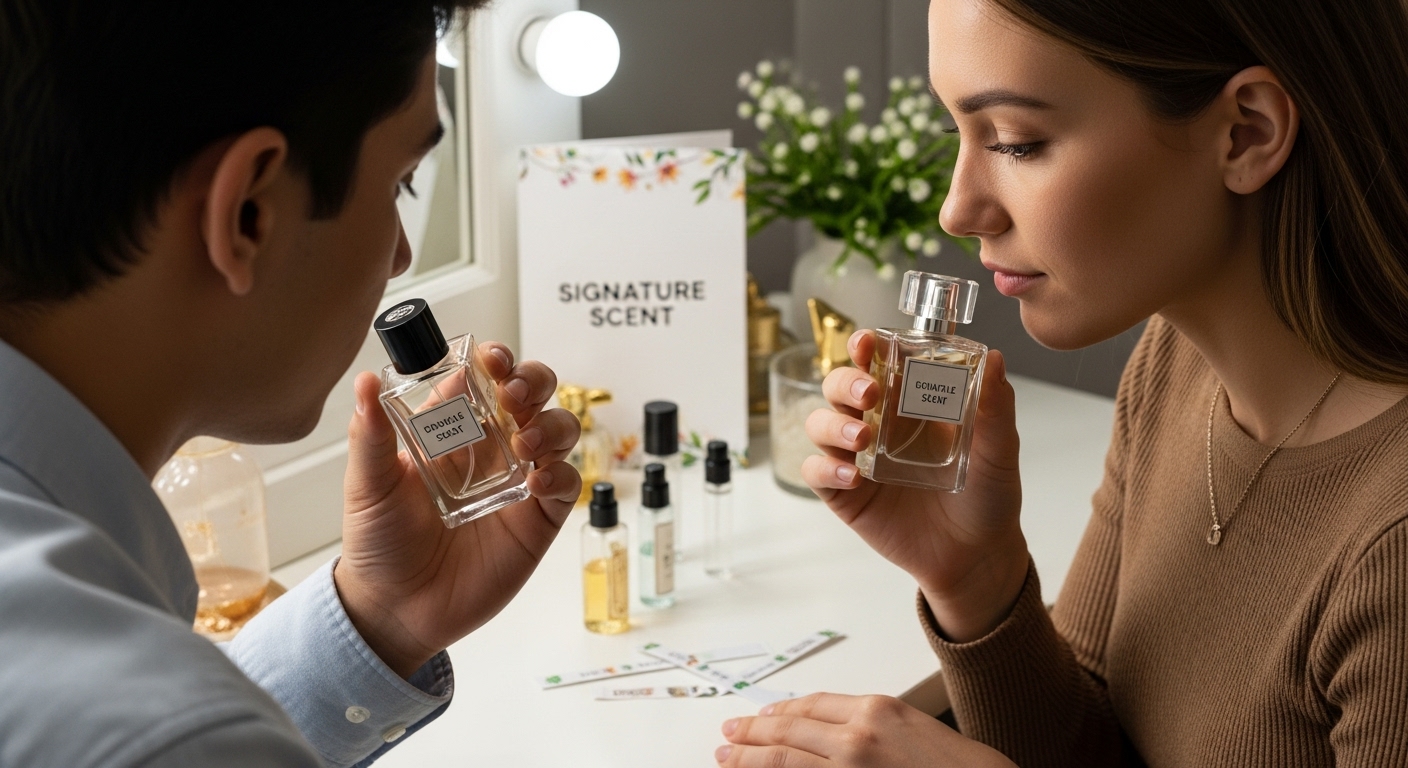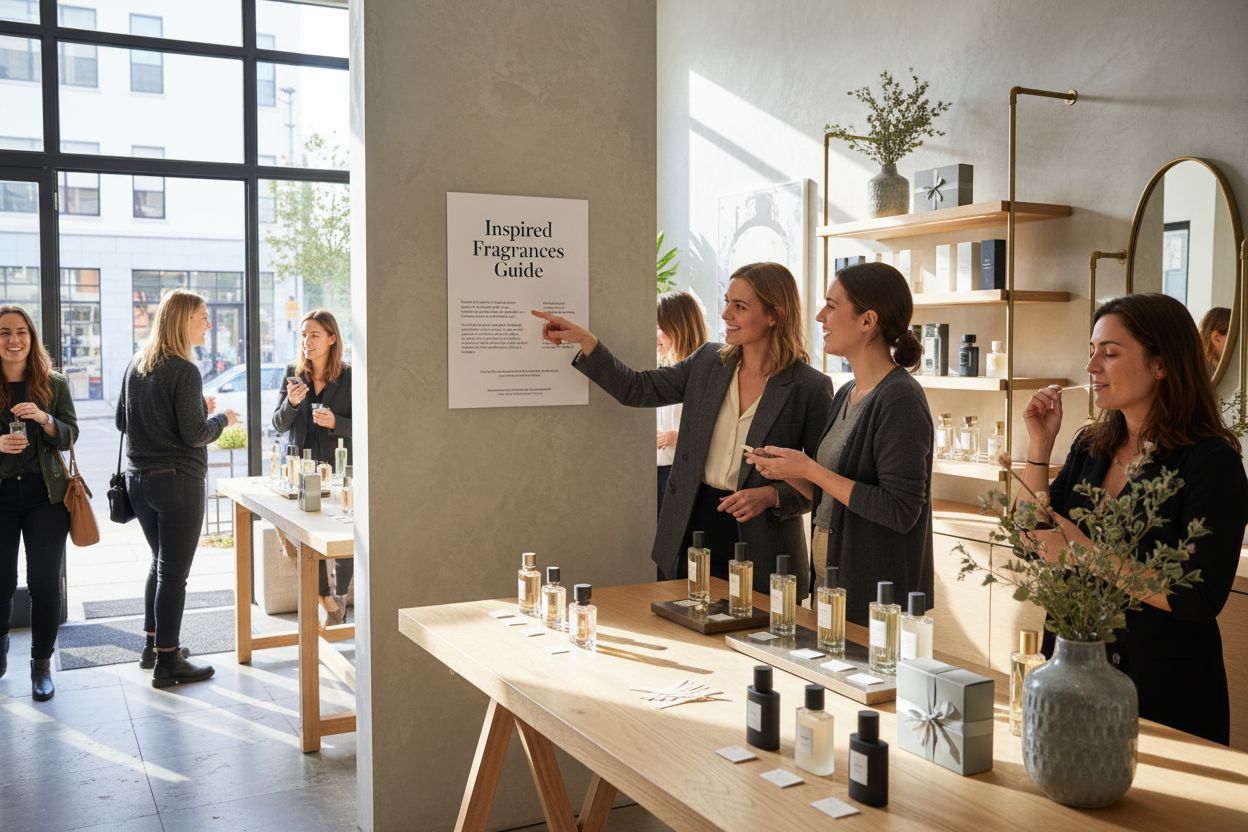Perfume might seem like a simple way to smell nice but there is far more to each bottle than meets the eye. Think about this: perfumes can contain as much as 98 percent ethanol and only 2 percent water, with the rest being highly concentrated aromatic compounds. Yet the real surprise is how choosing the right scent goes far beyond personal preference. A fragrance can change your mood, shape first impressions, and even act as a subtle form of communication that says more about you than any outfit could.
Table of Contents
- What Defines A Perfume And Its Categories?
- Why The Right Scent Matters: Emotional And Social Impact
- How Perfume Ingredients Influence Your Choice
- Understanding Fragrance Families And Their Characteristics
- Key Considerations When Buying Perfume As A Gift
Quick Summary
| Takeaway | Explanation |
|---|---|
| Understand perfume compositions | Perfumes consist mainly of ethanol and water, with aromatic compounds that create unique scents. |
| Know perfume categories | Classify perfumes by concentration and scent families to find the right fragrance for your needs. |
| Fragrance affects emotions | Scents can influence feelings and memories, impacting mood and social interactions significantly. |
| Choose gifts based on preferences | Successful perfume gifts require understanding the recipient’s personality, existing scents, and potential sensitivities. |
| Consider ingredient types | Recognise the difference between natural and synthetic ingredients for a scent that matches your preferences. |
What Defines a Perfume and Its Categories?
Perfumes represent sophisticated aromatic compositions crafted through precise blending of essential oils, fixatives, and solvents. Explore fragrance families in depth to understand their intricate world.
The Composition of Perfumes
A perfume is more than just a pleasant scent. According to the National Center for Biotechnology Information, perfumes are complex mixtures typically containing 98% ethanol and 2% water, combined with concentrated aromatic compounds. These aromatic compounds range from natural plant extracts to synthetic chemicals, creating unique sensory experiences.
Key characteristics of perfume composition include:
- Concentration levels determining intensity
- Essential oil percentages
- Balance of top, middle, and base notes
Perfume Categories and Classification
Perfumes are traditionally classified based on two primary systems: concentration levels and scent families. Concentration levels determine the perfume’s strength and longevity:

- Parfum/Extrait: 15-30% aromatic compounds
- Eau de Parfum: 8-15% aromatic compounds
- Eau de Toilette: 4-8% aromatic compounds
- Eau de Cologne: 2-5% aromatic compounds
Scent families represent another crucial classification method, grouping fragrances by their predominant aromatic characteristics. Common fragrance families include Floral, Oriental, Woody, Citrus, Chypre, and Gourmand, each offering a distinct olfactory experience that appeals to different personal preferences and occasions.
Understanding these nuanced categories helps individuals select fragrances that resonate with their personal style, skin chemistry, and desired emotional expression.
Below is a comparison table outlining the main perfume concentration categories and their respective characteristics, which clarifies the differences in strength and aromatic longevity among fragrances.
| Category | Aromatic Compounds (%) | Strength | Typical Longevity |
|---|---|---|---|
| Parfum/Extrait | 15–30 | Very strong | 6–8 hours or longer |
| Eau de Parfum | 8–15 | Strong | 4–6 hours |
| Eau de Toilette | 4–8 | Moderate | 2–4 hours |
| Eau de Cologne | 2–5 | Light | 1–2 hours |
Why the Right Scent Matters: Emotional and Social Impact
Fragrances transcend mere pleasant aromas, serving as powerful emotional communicators and social signals. Discover your unique scent narrative to understand their profound psychological influence.
Psychological Dimensions of Fragrance
Research reveals that scents profoundly impact human emotional landscapes. According to scientific investigations, natural odors can significantly modulate psychological states, influencing mood, alertness, and emotional well-being. Our olfactory system establishes direct neurological connections with brain regions responsible for processing emotions and memories.
Key psychological impacts of fragrances include:
- Triggering specific emotional memories
- Modulating stress and anxiety levels
- Enhancing personal confidence and self-perception
Social Signalling Through Scent
Perfumes function as sophisticated non-verbal communication tools. They communicate personal identity, cultural background, and emotional state without uttering a single word. A carefully selected fragrance can create powerful first impressions, signalling sophistication, approachability, or professional demeanour.
The social dynamics of scent selection involve nuanced considerations:
- Cultural perceptions of specific fragrance families
- Personal branding through olfactory choices
- Adapting scents to different social contexts
Ultimately, choosing the right perfume represents a deeply personal journey of self-expression, emotional management, and social interaction. By understanding fragrances as more than aesthetic accessories, individuals can leverage scents as powerful tools for personal and professional communication.
How Perfume Ingredients Influence Your Choice
Perfume ingredients represent far more than aromatic compounds; they are intricate chemical compositions that interact uniquely with individual body chemistry. Learn how to identify these subtle fragrance notes to refine your selection process.
The Science of Ingredient Selection
According to scientific research, perfume ingredient molecules interact with our genetic olfactory receptors in profoundly personal ways. Each individual’s genetic makeup determines how specific aromatic compounds are perceived, creating a uniquely subjective sensory experience.
Key factors influencing ingredient perception include:
- Genetic variations in olfactory receptors
- Personal biochemical interactions
- Emotional and memory associations
Natural vs Synthetic Ingredients
Perfume ingredients can be categorised into natural botanical extracts and synthetic molecular compounds. Natural ingredients like essential oils offer complex, nuanced profiles derived directly from plants, while synthetic molecules provide precise, consistent aromatic experiences.
Considerations when evaluating ingredients:
- Purity and sourcing of natural extracts
- Molecular complexity of synthetic compounds
- Environmental and ethical production methods
Understanding ingredient composition empowers consumers to make informed choices that align with personal preferences, skin chemistry, and olfactory sensitivities. The right combination of ingredients transforms a simple fragrance into a deeply personal olfactory signature.

Understanding Fragrance Families and Their Characteristics
Fragrance families represent sophisticated olfactory classifications that help individuals navigate the complex world of perfumery. Explore elegant fragrance examples to understand these intricate aromatic landscapes.
Core Fragrance Family Classifications
According to scientific research, perfume classification involves categorizing scents based on their predominant aromatic characteristics. These families serve as fundamental guideposts for understanding complex olfactory compositions, enabling consumers to articulate and discover their preferred sensory experiences.
Key fragrance families include:
- Floral: Dominated by flower-inspired notes like rose, jasmine, and lily
- Oriental: Rich, warm scents featuring spices, vanilla, and amber
- Woody: Earthy aromas with sandalwood, cedar, and patchouli undertones
- Citrus: Bright, refreshing notes of lemon, bergamot, and orange
- Chypre: Complex blends featuring moss, bergamot, and woody elements
- Gourmand: Sweet, edible-inspired fragrances with notes of vanilla, caramel
Personality and Fragrance Connections
Fragrance families extend beyond mere scent classification; they represent complex sensory narratives that intersect with personal identity. Different aromatic profiles communicate distinct emotional landscapes and personality traits, allowing individuals to express themselves through carefully selected olfactory signatures.
Individuals can leverage fragrance families to:
- Match scents with personal style and mood
- Explore emotional resonance of different aromatic profiles
- Understand how specific notes complement individual body chemistry
By comprehending these nuanced fragrance families, consumers transform perfume selection from a simple purchase into a deeply personal journey of self-expression and sensory exploration.
The following table summarises the core fragrance families and their defining characteristics, assisting readers in recognising scent types and matching them to personality preferences.
| Fragrance Family | Typical Notes | Overall Impression | Personality Fit |
|---|---|---|---|
| Floral | Rose, jasmine, lily | Romantic, soft | Elegant, classic |
| Oriental | Spices, vanilla, amber | Warm, exotic | Mysterious, bold |
| Woody | Sandalwood, cedar, patchouli | Earthy, rich | Grounded, sophisticated |
| Citrus | Lemon, bergamot, orange | Fresh, bright | Energetic, cheerful |
| Chypre | Moss, bergamot, woody elements | Complex, balanced | Confident, modern |
| Gourmand | Vanilla, caramel, edible accords | Sweet, cosy | Playful, youthful |
Key Considerations When Buying Perfume as a Gift
Selecting the perfect perfume requires thoughtful consideration and nuanced understanding of personal preferences. Discover elegant fragrance options to transform your gift-giving experience.
Understanding Recipient Preferences
According to research from Universiti Teknologi MARA, successful perfume gifts transcend mere packaging and aesthetics. The recipient’s personality, lifestyle, and existing fragrance preferences play crucial roles in selecting an appropriate scent.
Key factors to consider about the recipient include:
- Personal style and fashion choices
- Existing fragrance collection
- Professional and social environments
- Age and generational preferences
- Potential allergies or sensitivities
Navigating Fragrance Selection Strategies
Successful perfume gifting involves strategic approaches that balance personal insight with olfactory sophistication. Psychological research suggests that fragrances communicate complex emotional narratives, making them deeply personal accessories.
Considerations for thoughtful perfume selection:
- Match fragrance families to personality types
- Consider seasonal and occasion appropriateness
- Evaluate concentration levels (eau de toilette vs parfum)
- Balance between familiar and adventurous scent profiles
- Respect individual sensory preferences
Ultimately, a well-chosen perfume represents more than a gift—it becomes an intimate expression of understanding, appreciation, and personal connection. The most memorable fragrance gifts demonstrate profound emotional intelligence and careful consideration of the recipient’s unique sensory landscape.
Find Your Distinctive Perfume Match Today
Struggling to choose the perfect fragrance that genuinely reflects your personality and style? With so many intricate scent families, concentration levels, and ingredient profiles described in our guide, the search for a signature scent can feel overwhelming. At Niche Perfumes | Verset Collection, you can explore expertly curated luxury alternatives inspired by world-renowned designers, each crafted to help you discover your own unique aromatic identity without the premium cost.

Do not let confusion or high prices hold you back from enjoying high-quality perfume. Visit VersetParfums.Shop now to browse our extensive collection. Trust in authentic craftsmanship and European standards, and find your new signature scent with confidence. Experience the difference today, and start transforming your everyday moments with a fragrance that truly fits you.
Frequently Asked Questions
What are the different perfume categories?
Perfumes are primarily categorised based on concentration levels and scent families. Common categories include Parfum/Extrait (15-30% aromatic compounds), Eau de Parfum (8-15%), Eau de Toilette (4-8%), and Eau de Cologne (2-5%). Scent families include Floral, Oriental, Woody, Citrus, Chypre, and Gourmand.
How does fragrance composition affect my scent choice?
Fragrance composition, including the concentration of essential oils and the balance of notes (top, middle, and base), influences how a scent is perceived and its longevity on the skin. Understanding these factors can help in selecting a perfume that resonates with personal style and skin chemistry.
What is the significance of the olfactory system in perfume selection?
The olfactory system is directly linked to emotional processing and memory, making the choice of fragrance highly subjective. Different scents can trigger emotional responses, thereby impacting mood and personal identity.
How can I choose a perfume as a gift for someone?
When selecting a perfume as a gift, consider the recipient’s personal style, existing fragrance preferences, lifestyle, and any potential allergies. Matching the fragrance family to their personality type and keeping seasonal appropriateness in mind can enhance the gift’s impact.
Recommended
- How to Shop by Fragrance Family for the Perfect Scent – VersetParfums.Shop
- Master How to Identify Fragrance Notes in Perfumes – VersetParfums.Shop
- Niche Perfumes | Verset Collection – VersetParfums.Shop
- 7 Examples of Elegant Fragrances to Elevate Your Scent Game – VersetParfums.Shop
- AROMAS ENCAPSULADOS - kolorguide









0 comments